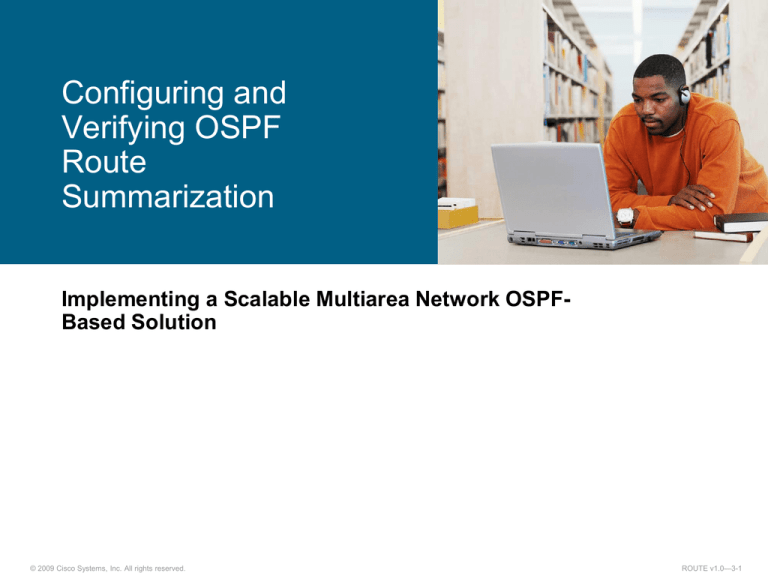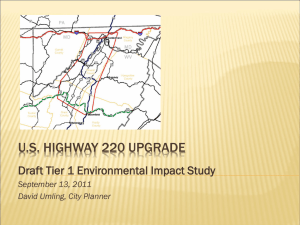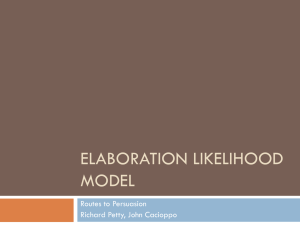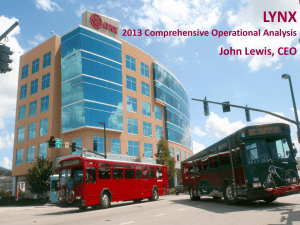
Configuring and
Verifying OSPF
Route
Summarization
Implementing a Scalable Multiarea Network OSPFBased Solution
© 2009 Cisco Systems, Inc. All rights reserved.
ROUTE v1.0—3-1
Summarization
Networks are normally translated into type 3 LSAs in other areas.
Route summarization is the consolidation of advertised
addresses.
– On ABR, summarize type 3 LSAs
– On ASBR, summarize type 5 LSAs
A good addressing plan is required.
A drawback is the possibility of suboptimal routing.
© 2009 Cisco Systems, Inc. All rights reserved.
ROUTE v1.0—3-2
Benefits of Route Summarization
Minimizes the number of routing table entries
Localizes the impact of a topology change
Reduces LSA flooding and saves CPU resources
© 2009 Cisco Systems, Inc. All rights reserved.
ROUTE v1.0—3-3
Interarea Route Summarization
A summary route will be generated if at least one subnet within
the area falls in the summary address range.
A summarized route metric will be equal to the lowest cost of all
subnets within the summary address range.
Only for the summary routes of connected areas:
– The ABR creates a route to Null 0 to avoid loops.
© 2009 Cisco Systems, Inc. All rights reserved.
ROUTE v1.0—3-4
Using Route Summarization
Interarea summary link carries a mask
One or more entries can represent several subnets
© 2009 Cisco Systems, Inc. All rights reserved.
ROUTE v1.0—3-5
Configure Interarea Route
Summarization
Configures type 3 summarization on ABRs
© 2009 Cisco Systems, Inc. All rights reserved.
ROUTE v1.0—3-6
Route Summarization Configuration
Example at the ABR
© 2009 Cisco Systems, Inc. All rights reserved.
ROUTE v1.0—3-7
External Route Summarization
Summarization can be used for external routes:
– on an AS boundary for type 5 LSAs (redistributed routes)
– on an NSSA ABR for type 5 translated from type 7
A summary route to Null 0 will be created for each summary range
© 2009 Cisco Systems, Inc. All rights reserved.
ROUTE v1.0—3-8
Configure External Route Summarization
Configures type 5 summarization of redistributed routes on
ASBRs
© 2009 Cisco Systems, Inc. All rights reserved.
ROUTE v1.0—3-9
Route Summarization Configuration
Example at ASBR
© 2009 Cisco Systems, Inc. All rights reserved.
ROUTE v1.0—3-10
Default Routes in OSPF
A default route is injected into OSPF as an external type 5 LSA.
Default route distribution is not on by default.
Benefits of default routes include:
– A smaller routing table
– Fewer resources used in the router
© 2009 Cisco Systems, Inc. All rights reserved.
ROUTE v1.0—3-11
Configure OSPF Default Route
The first command allows the ASBR to originate a type 5 default
route if it has the gateway of last resort.
The second command allows the ASBR to originate a type 5
default route even if there is no gateway of last resort (optional).
Use the route map to define a dependency on any condition
inside the route map (optional).
© 2009 Cisco Systems, Inc. All rights reserved.
ROUTE v1.0—3-12
Default Route Configuration Example
© 2009 Cisco Systems, Inc. All rights reserved.
ROUTE v1.0—3-13
Summary
Route summarization improves CPU utilization, reduces LSA
flooding, and reduces routing table sizes.
The area range command is used to summarize at
the ABR. The summary-address command is used to summarize
at the ASBR.
Default routes can be used in OSPF to prevent the need for a
specific route to each destination network. The benefits include a
much smaller routing table and an LSDB with complete
reachability.
OSPF uses the default-information originate command to inject
a default route.
© 2009 Cisco Systems, Inc. All rights reserved.
ROUTE v1.0—3-14
© 2009 Cisco Systems, Inc. All rights reserved.
ROUTE v1.0—3-15







